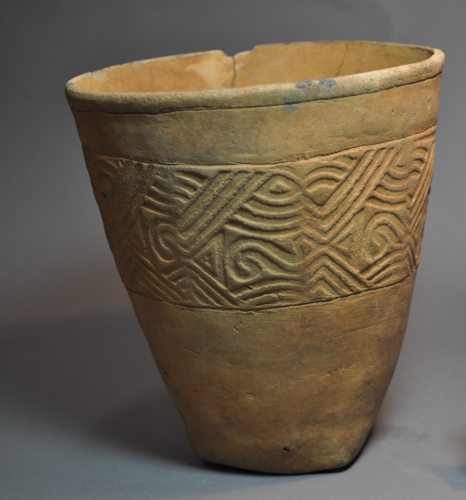Swift Creek Complicated Stamped pottery, and related types, were widely produced throughout Georgia, eastern Alabama, and northern Florida during the Middle and Late Woodland periods between roughly AD 100 and 800. Complicated stamped pottery preserves truly unique evidence of social interactions.
 Before drying and firing, the vessels were decorated with impressions from a carved wooden paddle. The unique “fingerprints” of individual carved wooden paddles can be recognized in the impressions on complicated stamped vessels, and the same paddle stamp often can be identified on vessels distributed across multiple sites, sometimes hundreds of kilometers apart. These “paddle matches” between sites lend detailed temporal and spatial resolution to social connections among distant communities.
Before drying and firing, the vessels were decorated with impressions from a carved wooden paddle. The unique “fingerprints” of individual carved wooden paddles can be recognized in the impressions on complicated stamped vessels, and the same paddle stamp often can be identified on vessels distributed across multiple sites, sometimes hundreds of kilometers apart. These “paddle matches” between sites lend detailed temporal and spatial resolution to social connections among distant communities.
References:
Pluckhahn, Thomas J., and Neill J. Wallis
2017 Social Networks and Networked Scholars: An Open-Access Database of Paddle Designs from Pottery of the Woodland Period in the American Southeast. Advances in Archaeological Practice 5(2):159-169. DOI: 10.1017/aap.2016.11
Pluckhahn, Thomas J., and Neill J. Wallis
2017 Swift Creek at a Human Scale. Southeastern Archaeology. DOI: 10.1080/0734578X.2017.1342067
Wallis, Neill J.
2011 The Swift Creek Gift: Vessel Exchange on the Atlantic Coast. University of Alabama Press, Tuscaloosa.
Ordering Info
Wallis, Neill J., Matthew T. Boulanger, Jeffrey R. Ferguson, and Michael D. Glascock
2010 Woodland Period Ceramic Provenance and the Exchange of Swift Creek Complicated Stamped Vessels in the Southeastern United States. Journal of Archaeological Science 37(10): 2598-2611. DOI: 10.1016/j.jas.2010.05.020.
Wallis, Neill J., Thomas J. Pluckhahn, and Michael D. Glascock
2016 Sourcing Interaction Networks of the American Southeast: NAA of Swift Creek Complicated Stamped Pottery. American Antiquity 81(4):717-736. DOI: 10.1017/S0002731600101052